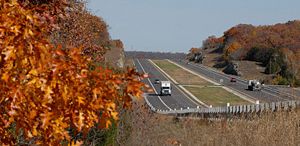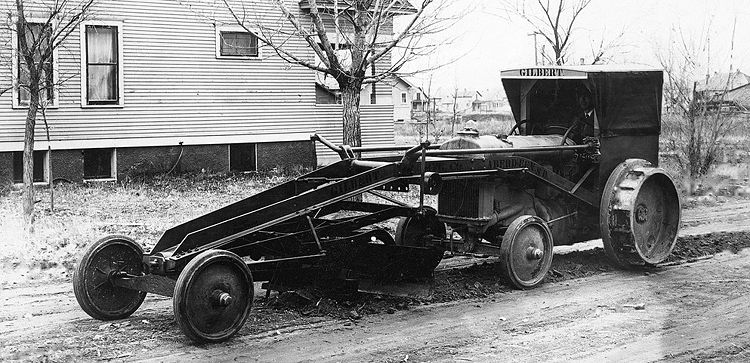230.2 Vertical Alignment
The topography of the land traversed has an influence on the alignment of roads and streets. Topography affects horizontal alignment, but it has an even more pronounced effect on vertical alignment. Variations in topography are generally separated into three classifications according to terrain:
- Level---Highway sight distances, as governed by horizontal and vertical restrictions, are generally long or can be made so without construction difficulty of major expense.
- Rolling---Natural slopes consistently rise above and fall below the road or street grade, and occasional steep slopes offer some restriction to the normal horizontal and vertical alignment.
- Mountainous---Longitudinal and transverse changes in the elevation of the ground with respect to the road or street are abrupt, with benching and side excavation frequently needed to obtain acceptable horizontal and vertical alignment.
These classifications pertain to the general character of a specific roadway corridor. Roadways in valleys, passes, or mountainous areas that have all the characteristics of roads or streets traversing level or rolling terrain should be classified as level or rolling. Generally, rolling terrain generates steeper grades than level terrain, causing trucks to reduce speeds below those of passenger cars; mountainous terrain has even greater effects, causing some trucks to operate at crawl speeds.
Contents
- 1 230.2.1 Rural Major Roads
- 2 230.2.2 Urban Major Roads
- 3 230.2.3 Minor Roads
- 4 230.2.4 Sight Distance
- 5 230.2.5 Stopping Sight Distance and K Factors
- 6 230.2.6 Decision Sight Distance
- 7 230.2.7 Passing Sight Distance
- 8 230.2.8 Sag Vertical Curve Controls
- 9 230.2.9 Intersections
- 10 230.2.10 Bridge Considerations
- 11 230.2.11 Grades
- 12 230.2.12 Ramps
- 13 230.2.13 Outer Roadways and Service Roads
- 14 230.2.14 Profile Grades on the Plans
230.2.1 Rural Major Roads
The operational characteristics of a roadway are directly affected by the length and steepness of the vertical alignment. The designer is to consider the road’s terrain, traffic volume, expected capacity, LOS and other safety factors in order to properly anticipate the posted speed. Highways will be designed according to their anticipated posted speed as opposed to an arbitrary design speed.
Once the anticipated posted speed is identified, the road’s vertical alignment can be selected. The AASHTO publication A Policy on Geometric Design of Highways and Streets (the Green Book) can be used as guidance to determine the maximum vertical grades.
When terrain or some other factor causes the maximum grade to be impractical for a roadway segment, a grade in excess of those indicated in the Green Book can be incorporated into the design and the posted speed for that roadway decreased.
230.2.2 Urban Major Roads
While the operational characteristics of a roadway are directly affected by the length and steepness of the vertical alignment, extensive steep terrain in urban areas is not typically encountered. While no maximum grade for urban roads is specified, the Green Book’s table “Recommended Maximum % Grades for Rural Major Roads” can be consulted to determine an urban major road’s grade.
230.2.3 Minor Roads
Terrain, traffic volume and the anticipated posted speed are to be considered when selecting a roadway’s maximum vertical grade.
230.2.4 Sight Distance
Sight distance is the length of the roadway ahead that is visible to the driver. Sight distance is an element of design that affects the safe and efficient operation of a roadway and it is given careful consideration during the location study and preparation of the preliminary plan. Stopping sight distance, based on the anticipated posted speed, is the sum of the distance for braking reaction and the braking distance required for a driver to stop the vehicle after sighting an object on the roadway. Passing sight distance, based on the anticipated posted speed, is the minimum distance required to safely make a normal passing maneuver on two-lane roadways at passing speeds representative of nearly all drivers. Operational sight distance is a portion of the passing sight distance and is the minimum distance necessary for safe passing at the prevailing speed of traffic (85th percentile speed). Operational sight distance is used by the Traffic Division in establishing no passing zones by marking yellow lines on the roadways. Minimum design controls have been established for stopping and passing sight distances. Consideration for the design of a longer vertical curve to provide for operational sight distance is based on good engineering judgment and economy
230.2.5 Stopping Sight Distance and K Factors
The minimum stopping sight distances and “K” factors for various anticipated operating speeds are given in the Green Book. These controls are based on a 3.5 ft. height of eye and a 2.0 ft. height of object. The “K” factors are approximate only and are used as a guide in determining the length of the vertical curve. K values are a measure of passenger comfort. Use of small K values is not recommended. The stopping sight distance, as determined by formula, is used as the final control. Where practical, vertical curves at least 300 ft. in length are used. Table 3-36 of the AASHTO Greenbook is used to determine the length of a sag vertical curve required for any SSD based on change in grade. Table 3-34 of the AASHTO Greenbook is used to determine the length of a crest vertical curve required for any SSD based on change in grade.
230.2.6 Decision Sight Distance
Decision sight distance is used where the stopping sight distance is inadequate to allow a reasonably competent driver the distance to react to potentially hazardous situations. This condition may be present in a roadway environment that is cluttered visually, an intersection congested with traffic, a median crossover, or has an unusual roadway geometric configuration. In decision areas the decision sight distance gives a greater margin for error and provides the distance to maneuver a vehicle safely. See Table 3-3 of the AASHTO Green Book for decision sight distance values.
230.2.7 Passing Sight Distance
Passing sight distance for use in design is determined on the basis of the length needed to complete normal passing maneuvers in which the passing driver can determine that there are no potentially conflicting vehicles ahead before beginning the maneuver. While there may be occasions to consider a multiple passing (where two or more vehicles pass or are passed) it is not practical to assume such conditions in developing design criteria. Instead, sight distance is determined for a single vehicle passing a single vehicle. Longer sight distances occur in design of a roadway and such locations can accommodate an occasional multiple passing. Minimum passing sight distances for design of two-lane roadways incorporates certain assumptions about driver behavior. Actual driver behavior in passing maneuvers varies widely. To accommodate these variations, the design criteria for passing sight distance should accommodate the behavior of a high percentage of drivers rather than the “average” driver.
The minimum passing sight distance for two-lane roadways is determined as the sum of the following four distances:
- The distance traversed during perception and reaction time including initial acceleration.
- The distance traveled while passing in the left lane.
- The distance between the passing vehicle at the end of the maneuver and the opposing vehicle.
- The distance traveled by the opposing vehicle for two-thirds of the time the passing vehicle occupies the left lane (see Exhibit 3-4 of the Green Book).
Table 3-4 of the AASHTO Green Book can be used to determine passing sight distances for various speeds. These values are based on a 3.5 ft. height of eye and a 3.5 ft. height of object. Horizontal alignment is also considered in determining the location, extent, and percentage of passing distances. If passing maneuvers are to be performed on upgrades under the same assumptions about the behavior of the passing and the passed vehicles, the passing sight distance should be greater than the derived design values. Specific adjustments for design use are not available; however, the designer should recognize the desirability of exceeding the values shown in Exhibit 3-7 where practicable.
Procedures in the Highway Capacity Manual indicate another criterion for passing sight distance design on two-lane roadways that are several miles in length. The available passing sight distance along this length can be summarized to show the percentage of length with greater-than-minimum passing sight distance. Analysis of capacity related to this percentage can indicate whether or not alignment and profile adjustments are needed to accommodate the design hourly volume (DHV). When roadway sight distances are analyzed over the whole range of lengths within which passing maneuvers are made, a new design criterion may be evaluated. Where high traffic volumes are expected on a roadway and a high level of service is to be maintained, frequent of nearly continuous passing sight distances are to be provided.
Passing sight distance is not a design consideration for divided lane facilities.
230.2.8 Sag Vertical Curve Controls
At least four different criteria for establishing lengths of sag vertical curves are recognized to some extent. They are:
- Headlight sight distance
- Passenger comfort
- Drainage control
- General appearance
The "K" factors shown in Figure 3-44 and Table 3-36 of the Green Book are for the most part based upon headlight sight distance and are to be used in the design of sag vertical curves. Where practicable, vertical curves at least 300 ft. in length are used.
In some restrictive situations, the sag “K” factor determined above may be reduced to satisfy passenger comfort criteria. The length of vertical curves needed to satisfy the “comfort factor” at the posted speed is about 50 percent of that needed to satisfy the headlight sight distance criterion for the normal range of design conditions. The following formula (based on 3-51 of the Green Book) may be used to determine the length of the sag vertical curve for the reduced K factor.
where:
- L = length of sag vertical curve (ft.)
- A = algebraic difference in grades (percent)
- V = anticipated posted speed (mph)
230.2.9 Intersections
Important sideroads should intersect the through roadway at a -1% rate of grade from the shoulder of the through roadway, if practicable. When the -1% rate is not practicable, the grade is designed with good engineering judgment, keeping in mind the difference in grade between the cross slope of the through roadway and the grade of the sideroad. The sideroad grade will discourage accumulation of water at the edge of the through roadway. It will also provide a relatively flat grade for a distance necessary to allow storage for stopping traffic. Detailed information concerning intersection design can be found in the article entitled At-Grade Intersections.
230.2.10 Bridge Considerations
It is desirable to avoid vertical and horizontal curves on bridges. When a horizontal curve is unavoidable on a bridge, spirals and superelevations are not to be placed on the bridge itself unless absolutely necessary. To facilitate drainage, it is preferable that level grades not be used on a bridge; however, if the bridge is on a level grade, the roadway profile grade is to be kept as level as possible for a distance of 50 ft. from the ends of the bridge at locations where the approaching roadway grade is below the bridge elevation. This will reduce the impact load on the bridge. Flat grades and sag curves can cause drainage problems on bridges, especially those over railroads or other roadways, and should be avoided. To avoid drainage problems, the low point of a sag curve will not be placed on the bridge unless absolutely necessary.
Minimum vertical clearances over roadways will be maintained. The Design Division must approve use of a reduction of vertical clearance below the minimum, as a design exception. Once approved, the project manager will notify the District Construction and Materials engineer to ensure measurement and posting of the final vertical clearance is accomplished.
230.2.11 Grades
The profile grade in a flood plain is established to keep the roadway’s shoulder a minimum of 1 ft. above design high water. This applies to all types of roadways. The stream gradient must be considered in establishing profile grades in flood plains. The Bridge Division will determine the design high water elevation to be used in establishing the profile grade.
230.2.12 Ramps
Grade considerations for at-grade intersections also apply to the area where an interchange ramp intersects a crossroad. Where ramps merge with the through roadway, grades are established by projecting the through roadway profile grade to the edge of the ramp pavement, using crown and controlling cross slopes at sufficient points in the vicinity of the ramp nose to determine a grade for the ramp in this area. Otherwise grade control for ramps are the same as for other roads, based on the anticipated posted speed. Additional information concerning sag vertical curves can be helpful when establishing grade controls for ramps.
230.2.13 Outer Roadways and Service Roads
Design controls for vertical alignment on outer roadways and service roads are based on the anticipated operating speed just the same as the controls for other roadways. However, the vertical alignment is modified to the extent necessary to provide adequate service to adjacent properties. Grades in the vicinity of streams are established to provide at least the same service level in relation to the stream high water that existed prior to the roadway improvement.
230.2.14 Profile Grades on the Plans
The profile grade information shown on the plans includes rate of grade, each P.I. station and elevation, length of vertical curves, the vertical curve "K" factors, and the stopping sight distance for crest vertical curves. P.I. stations are shown to the nearest 0.01 ft. P.I. elevations are shown to the nearest 0.01 ft. The length of vertical curve is set in 10 ft. increments. The "K" factor is shown to the nearest whole number. The stopping sight distance is shown in 5 ft. increments. All data for profile grades on outer roadways, service roads, and other roads are shown on plans in the same manner.
When Linear Grading, Class 1, is used a computed profile grade is not shown on the plans. When Linear Grading, Class 2, is used a dashed grade line is shown on the plans only where it is necessary to control the grade. This differentiates Linear Grading, Class 2, from Volume Grading.




